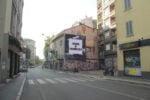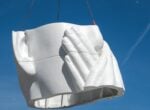Taiwan Pavilion – Doing Time
.jpg)
Evento Collaterale 57. Biennale di Venezia.
Comunicato stampa
Doing Time, Tehching Hsieh exhibition at Venice Biennale 2017
Taipei Fine Arts Museum (TFAM) is delighted to release further details of Taiwan’s contribution
to the 57th International Art Exhibition, Venice Biennale 2017 by the artist Tehching Hsieh,
entitled Doing Time.
Born in 1950 in Taiwan, the critically acclaimed artist is now mounting the most comprehensive
exhibition of his work to date. Seen by many as a highly influential figure in the history of
conceptual and performance art, Hsieh’s renown emanates from a staggering series of One Year
Performances in the early 1980s: ‘rule-based’ works conducted at the limits of human endurance.
These pieces explored self-discipline, physical and psychological control, notions of freedom,
visibility and the nature of human relations. The exposure of his work, and the discourse
accompanying it, has proliferated with the turn to performativity and “durational aesthetics” in
contemporary art, and the increasing entry of works of performance into major museum
collections.
Individual documentary exhibitions of Hsieh’s One Year Performances have previously been
shown at the Guggenheim Museum and Museum of Modern Art, New York, the Ullens Centre for
Contemporary Art, Beijing, The House of World Cultures, Berlin, Centro de Arte Hélio Oiticica, Rio
de Janeiro, and the Liverpool Biennial. His work has also entered the collections of Tate Modern,
London and Hong Kong’s M+. But Doing Time promises to be the first occasion that several of
Hsieh’s year-long works will have been seen together in their fullest forms, as well as revealing
previously un-exhibited early works performed in Taiwan, that shape the aesthetic concerns of
his later epic endeavors.
Hsieh’s acclaimed “Time Clock Piece” will form one part of the exhibition: the artist punched in to
a worker’s time clock on the hour every hour for an entire year. On each occasion he also took a
still image on a 16mm camera of his standing to attention beside the clock. Sleep deprivation was
pitted against the demand to be upright and visible. His ordeal resulted in one of the most
uncanny and extraordinary performance artifacts made by an artist: a six-minute film of Hsieh’s
tremulous body floating beside a whirling clock, wracked by the rapid passage of an immense
wave of time.
Hsieh’s preoccupation with freedom and constraint is equally evident in his “Outdoor Piece”, also
exhibited in Doing Time, where he spent a year on the streets of Manhattan without taking shelter
of any kind. His ability to roam freely comes at the cost of physical degradation, vulnerability and
the violence of the law. Many of the materials from his year outside will be exhibited, including
minutely detailed maps of his daily wanderings and stark photographs of the solitude of life on
the street.
A person of profound actions and succinct words, Hsieh explains the philosophy behind his art
making in plain terms: “Life is a life sentence. Life is passing time. Life is freethinking.” The title
of the exhibition, Doing Time, not only refers to Hsieh’s investment in long durations, but his
personal philosophy and creative history (his first One Year Performance was spent in silence
locked in a cage). It is also a knowing reference to the very fitting location of the exhibition in the
historic halls of the Palazzo delle Prigioni, Venice: the former prison of the Palazzo Ducale.
Curator of the exhibition Adrian Heathfield argues that Doing Time is “far from being a
straightforward historical exhibit.” “Hsieh’s works,” he says, “all question the relation between
the lasting document, the archive and the event of performance: the ways the past can linger
within the present.” The exhibition assembles Hsieh’s meticulous, often excessive documentary
materials gathered over the duration of each year of work into overwhelming installations.
2/5
Heathfield also stresses what he calls “Hsieh’s forceful address to contemporary conditions.”
Hsieh’s art, he argues, “was incredibly prescient in the understanding that the technologies of
capitalism would capture and accelerate life itself, turning sentient experience into productive
labor.”
Heathfield sees the significance of Hsieh’s oeuvre as arising from his art world outsider status and
his years as an illegal immigrant in New York. Hsieh’s work constantly invokes the qualities of
migrant experience: subjugation, precariousness and the struggle to survive. “The performances
speak to and from the life of those who have nothing, in common,” Heathfield says. Of Hsieh’s
tireless endurance of physical abjection Heathfield remarks, “each of these works is about forms
of bare existence in which resilience is pitched against adversity, and the fugitive qualities of life
are valued in their passing.”



